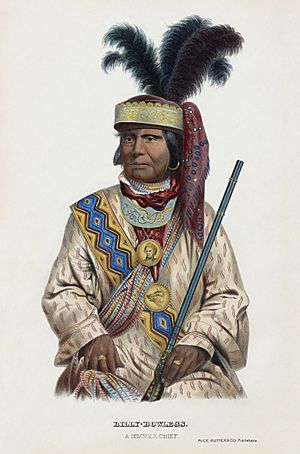Billy Bowlegs facts for kids
Holata Micco (also known as Billy Bowlegs) was an important leader of the Seminole people in Florida. His name, Holata Micco, means "Alligator Chief." He led the Seminoles during the Second Seminole War and was their main chief during the Third Seminole War.
Billy Bowlegs led his people in their last major fight against the United States government. When it became clear they could not win and faced starvation, he agreed to move his people. In 1858, they relocated to Indian Territory, which is now Oklahoma. He is buried there today.
Contents
Who Was Billy Bowlegs?
Billy Bowlegs was born around 1810. He came from a family of important Seminole chiefs. His family was part of the Oconee tribe of the Seminole nation. He was born in a village called Cuscowilla, near what is now Paynes Prairie Preserve State Park in Florida.
His father was named Secoffee, and the chief Micanopy was thought to be his uncle. The name "Bowlegs" might have come from an earlier Seminole chief named Bolek. There is a story that he had bowlegs from riding horses, but this is not confirmed.
Fighting for His People
Billy Bowlegs signed the Treaty of Payne's Landing in 1832. However, he refused to leave Florida, as the treaty required. He became a well-known leader during the Second Seminole War, which lasted from about 1835 to 1842.
After other important Seminole chiefs were captured or died, Billy Bowlegs and his group of about 200 warriors became the main fighters. When the war ended in 1842, the U.S. government invited Bowlegs to Washington, D.C. This was to show him how powerful the United States was.
Billy Bowlegs and his group lived peacefully for a while. But in 1855, U.S. Army engineers and surveyors entered his land in Southwest Florida. They cut down banana trees and destroyed property while building forts. Some historians believe these actions were meant to make Bowlegs angry. The goal was to give the settlers a reason to force the Seminoles out.
If that was the plan, it worked. Billy Bowlegs led his warriors in attacks against settlers for the next few years. This period is known as the Third Seminole War. The Army found it hard to defeat his fighting style, which was called guerrilla warfare. This means fighting in small, surprise attacks rather than large battles.
Moving West
In early 1858, the U.S. government tried a new approach. They brought Chief Wild Cat from the Western Seminole back to Florida. Wild Cat was asked to convince Bowlegs to move willingly. The U.S. government offered Bowlegs $10,000 to relocate. His chiefs were offered $1,000 each, and other warriors and people were offered less.
At first, Billy Bowlegs and his people refused. But later that year, his group of 123 people agreed to move. Billy's Creek in Fort Myers, Florida is named after him. This is where he was forced to surrender in 1858.
In May 1858, Billy Bowlegs and his followers traveled to New Orleans. From there, they went to Arkansas and then to their new home in the Indian Territory. A journalist at the time wrote that the chief had "two wives, one son, five daughters, and a hundred thousand dollars in hard cash." After arriving in Indian Territory, Billy Bowlegs became a leading chief there. He and his daughters became important landowners.
Other People Named Billy Bowlegs
There was another person named Billy Bowlegs who became famous. This was Sonuk Mikko, who was a captain in the Union Army during the American Civil War. Sometimes, people have confused Holata Micco (the chief) with Sonuk Mikko (the Civil War captain), but they were different people.



